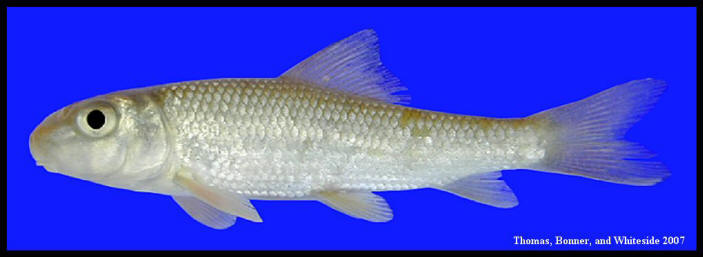|
|
||
|
Moxostoma erythrurum golden redhorse
THIS ACCOUNT IS IN PROCESS. PLEASE CHECK BACK LATER FOR ADDITIONAL INFORMATION.
Type Locality Ohio River (Rafinesque 1818).
Etymology/Derivation of Scientific Name
Synonymy Catostomus erythrurus Rafinesque 1818:354.
Characters Maximum size: 78 cm TL (Page and Burr 1991).
Coloration: Tip of dorsal fin blackish; caudal fin yellowish; lower sides golden to red; caudal fin without a black streak (Hubbs et al. 2008). Peritoneum colorless to silvery (Goldstein and Simon 1999).
Counts: Dorsal fin rays 13 (Hubbs et al. 2008).
Mouth position: Subterminal (Goldstein and Simon 1999).
Body shape: Dorsal fin base less than ¼ of standard length; 4-18 dorsal fin rays (Hubbs et al. 2008).
External morphology: Lateral line complete and well developed in adults (Hubbs et al. 2008).
Internal morphology: Air bladder with 3 chambers (Hubbs et al. 2008). Intestine long, little differentiated, 2-3 long coils (Goldstein and Simon 1999).
Distribution (Native and Introduced) U.S. distribution: Widely distributed throughout the eastern United States (Hubbs et al. 2008). Jenkins (1980) noted Moxostoma erythrurum widely distributed in Mobile drainage of Gulf slope, Mississippi, Ohio, and lower Missouri basins, southern Great Lakes basin excluding Lake Superior drainage, upper Red River of North and Lake of the Woods drainage, and Roanoke and James drainages on Atlantic slope; recently found (perhaps introduced) in Potomac drainage; species avoids lowlands of central Mississippi Valley; relict populations inhabit southwest Mississippi.
Texas distribution: Red River (Hubbs et al. 2008).
Abundance/Conservation status (Federal, State, NGO) Currently Stable (Warren et al. 2000) in the southern United States. Species often common (Jenkins 1980).
Habitat Associations Macrohabitat: Small to large streams and rivers (Jenkins 1980).
Mesohabitat: Inhabits streams and rivers with varied substrates, generally in pools over sand or silt; occasionally found in lakes (Jenkins 1980).
Biology Spawning season: During spring (Jenkins 1980).
Spawning habitat: Spawns in runs and riffles of largely gravel, water 17-22°C (Jenkins 1980).
Spawning behavior: Nonguarder; open substratum spawner; lithophil – rock and gravel spawner with benthic larvae that hide beneath stones (Simon 1999).
Fecundity:
Age at maturation: 3 to 5 years (Jenkins 1980).
Migration:
Growth and Population structure:
Longevity: Up to 8 years (Jenkins 1980).
Food habits: Invertivore; diet included immature insects, worms and mollusks; 46% Tricoptera, 27.1% Tendipedidae, 13.6% Ephemeroptera, 3.4% Sphaeriidae, 2.1% Copepoda (Goldstein and Simon 1999). Jenkins (1980) listed main food items: small mollusks, microcrustaceans, insects, detritus, and algae.
Phylogeny and morphologically similar fishes Moxostoma erythrurum allied with several species including the blacktail redhorse (M. poecilurum) which is also found in Texas (Buth 1978; Jenkins 1980).
Host Records
Commercial or Environmental Importance
References Buth, D.G. 1978. Biochemical systematics of the Moxostomatini (Cypriniformes, Catostomidae). Ph.D dissertation, Univ. Illinois. Urbana-Champaign. 191 pp. Goldstein, R.M., and T.P. Simon. 1999. Toward a united definition of guild structure for feeding ecology of North American freshwater fishes. pp. 123-202 in T.P. Simon, editor. Assessing the sustainability and biological integrity of water resources using fish communities. CRC Press, Boca Raton, Florida. 671 pp.
Hubbs, C., R.J. Edwards, and G.P. Garrett. 2008. An annotated checklist of the freshwater fishes of Texas, with keys to identification of species. Texas Journal of Science, Supplement, 2nd edition 43(4):1-87. Jenkins, R.E. 1980. Moxostoma erythrurum (Rafinesque), Golden redhorse. pp. 421 in D. S. Lee et al., Atlas of North American Freshwater Fishes. N. C. State Mus. Nat. Hist., Raleigh, i-r+854 pp. Meyer, W.H. 1962. Life history of three species of redhorse (Moxostoma) in the Des Moines River, Iowa. Trans. Amer. Fish. Soc. 91(4):412-419. Miller, R.J., and H.E. Evans.(1965. External morphology of the brain and lips in catostomid fishes. Copeia 1965(4):467-487.
Page, L. M. & B. M. Burr. 1991. A field guide to freshwater fishes of North America north of Mexico. Houghton Mifflin Company, Boston, Massachusetts. 432 pp.
Rafinesque, C.S. 1818. Discoveries in natural history, made during a journey through western region of the United States, by Constantine Samuel Rafinesque, Esq. Addressed to Samuel L. Mitchill, President, and other members of the Lyceum of Natural History, in a letter dated at Louisville, Falls of the Ohio, 20th July, 1818. Amer. Month. Mag. Crit. Rev. 3(5):354-356. Simon, T. P. 1999. Assessment of Balon’s reproductive guilds with application to Midwestern North American Freshwater Fishes, pp. 97-121. In: Simon, T.L. (ed.). Assessing the sustainability and biological integrity of water resources using fish communities. CRC Press. Boca Raton, Florida. 671 pp.
Warren, M.L., Jr., B.M. Burr, S.J. Walsh, H.L. Bart, Jr., R.C. Cashner, D.A. Etnier, B.J. Freeman, B.R. Kuhajda, R.L. Mayden, H.W. Robison, S.T. Ross, and W.C. Starnes. 2000. Diversity, Distribution, and Conservation status of the native freshwater fishes of the southern United States. Fisheries 25(10):7-29. |
||
|
|
||
